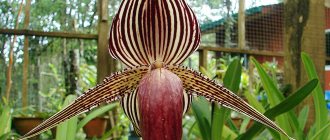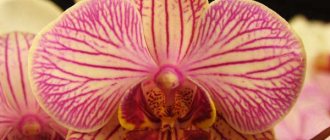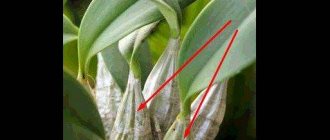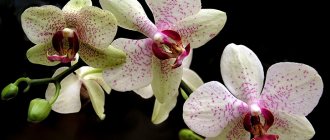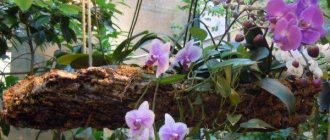Golden Beauty is a hybrid orchid, coming from the phalaenopsis genus, which means it is undemanding to the conditions of its maintenance and is distinguished by its prolific flowering. With proper treatment, it lives for a long time, without becoming a burden for its owner, decorating the house with delicate buds, and also filling the air with a divine aroma. Find out from this article why the plant is interesting, how to care for and propagate it, and also what diseases and pests are dangerous to it.
Origin and history of the species
Phalaenopsis Beauty Golden is an epiphytic orchid artificially bred by breeders. Its ancestors come from the countries of Southeast Asia and Australia. They live there to this day, preferring to settle mainly in trees and less often on rocks.
We find the first mention of phalaenopsis in the diaries of the German naturalist Georg Rumph. At the end of the 17th century, he visited the island of Ambon, part of the Moluccas archipelago, where he saw an amazing flower.
The scientific description of the orchid was assigned almost two centuries later - in 1825 by Karl Blum, head of the Leiden Botanical Garden. He traveled to Southeast Asia, where on one of the small islands he discovered a flower resembling a moth.
The plants in question quickly became popular in Europe. The price of orchids turned out to be extremely high. So many botanists were able to make considerable fortunes by breeding them.
Around the same time, work began on creating new varieties, as a result of which the flower discussed in this article appeared.
General description of phalaenopsis
Phalaenopsis is a numerous species belonging to the group of epiphytes. Plants that live on other plants - phorophytes, but are not harmful to them. Not parasitic. They do not take nutrients from others. They are used as if for support.
Here you are holding a pot of this plant in front of you. What do you see? Take your time. I'll tell you. After all, most people immediately pay attention to the flowers:
- We'll start with the leaves. Always green . They may have some kind of design. Attractive with marble colors. Their length is from 5 to 30-40 cm, and maybe up to 50 cm. Quantity - 4-7;
- From the axils of these leaves the roots go down. Light green with a layer of velamen. May be flattened;
- And the peduncle is up. Maybe not one, but several;
- And even have branches with flowers. Both big and small. Like butterflies. The name comes from them. They can also be aromatic;
- And stop your gaze on the pots. It’s not the size, but their transparent appearance that will surprise you. This makes it convenient to monitor the condition of the aerial roots.
Habitat, territory of distribution. History of the discovery of the species
- They came to civilized Europe from the tropical forests of Southeast Asia. But note that both China and Japan still claim to be the birthplace of this flower. And historians also talk about their popularity three thousand years ago;
- But they became well known after the description of Karl Ludwig Blume at the end of the nineteenth century. In the twilight of the jungle, the beautiful flowers on the tree seemed like butterflies to him;
- Before this, there were already stories by Georg Rumph about interesting plants found on the island of Ambon (Moluccas);
- Carl Leinaeus called it Epidendrum delightful . This is in his work “Species of Plants”;
- That’s where the name came from: Phalania – moth and opsis similarities . And then many naturalists and scientists called it differently: Doritis;
- Grafia;
- Kingidium;
- Lesliea;
- Sunadena;
- Polystylus;
- Kingiella.
Phalaenopsis got its name from its resemblance to a night moth.
Its abbreviation (or shortened name) is Phal. And on the Plant List website you will find 70 varieties of the Phalaenopsis genus.
Now it’s prestigious to tell how you relaxed in Phuket. True, few people talk about living orchids seen in nature. But it would be interesting to listen to flower lovers. After all, the tropical climate is just optimal for their natural habitat. This is their homeland. And the Philippines, northeastern Australia, India. Humid and warm climate. And it doesn’t matter whether it’s mountains or plains.
And the next two centuries brought them enormous popularity. Especially over the last couple of decades. But the myth about the exceptional conditions for their cultivation has not yet been completely dispelled. Those who have seen them in botanical gardens and greenhouses are no longer surprised by these magnificent plants growing in apartments and offices.
They grow special hybrids for this. And this is a big business. An apple tree, even an elite one, can cost you 200-400 rubles (50-100 UAH). And for phalaenopsis you have to pay from 800 to 3000 rubles. And even 5-8 thousand is not the limit. Don't be alarmed. This is for collectors. The championship belongs to Taiwan. Look at the tags. Where did the flowers come from?
Phalaenopsis is native to the tropics.
Color options
You can say it differently. There are so many different colors of phalaenopsis. And not only yellow or golden ones:
- Not all are solid colors;
- And with speckles;
- And with stripes;
- And with the obligatory lip. It often differs from the main color. And it’s very noticeable.
Detailed description of the Golden Beauty orchid
The flower has all the specific characteristics that allow it to be classified specifically as a phalaenopsis.
The culture has wide, elongated leaves. They are distinguished by their rigidity, fleshiness, skin density and glossiness. The shade is deep green.
Peduncles are standard in height for most phalaenopsis - up to 0.6 m, branched, erect. They grow from the axils, like aerial roots. The stem is short and is lost in the leaf rosette.
Phalaenopsis variety Beauty is unpretentious, blooms magnificently and abundantly. The buds smell pleasant and have a diameter of up to 80 mm. The number of shades is amazing.
Orchids found:
- golden;
- ocher;
- pale pink;
- lilac;
- motley.
The lip is usually distinguished by a contrasting, predominantly crimson or crimson color. Petals can be velvety, matte or waxy.
Features of an orchid
The Golden Beauty variety is not found in nature. At the same time, there are no anatomical differences between it and natural species.
Our flower, however, has stronger immunity, it quickly adapts to new conditions and is very unpretentious. This allows it to be grown and propagated even by those owners who are not too experienced in the intricacies of keeping phalaenopsis.
Advice: with proper care, Golden Beauty blooms steadily and for a long time, produces a lot of buds and does not cause any special trouble for the owners. However, it is necessary to disturb the orchid less - it does not tolerate overprotection.
Phalaenopsis varieties Golden Beauty, photo
The Elegant Beauty variety is very interesting. This orchid is distinguished by variegated blooms. The petals are decorated with complex patterns consisting of dark brown dots of different sizes. The main color is soft purple.
Solid gold (Solid Gold) produces two peduncles at once. Their height reaches an average of 0.4 m, but sometimes exceeds 0.8 m. The plant produces medium-sized (about 45 mm) buds of an almost traditional shape for phalaenopsis. Their color is peachy-gold, and the petals are decorated with not too flashy stripes. The culture can bloom for up to 2 months.
Brother Sara Gold (Brother Sara Gold) is another variety of Beauty orchid. This variety has small buds, bright pink in the center and golden towards the edges. Additionally, they are decorated with stripes and small, brick-colored specks.
Gold Leopard produces whimsical, angel-like flowers in a lilac hue. In the center there is a pattern of burgundy dots on an almost white background. The lip is light, with an orange border.
Golden Tresor is a light purple orchid whose petals are decorated with stripes and beige streaks at the tips. The velvety surface of the flowers gives additional charm to phalaenopsis.
These are not all Beauty varieties; there are about twenty-five of them. Unfortunately, it is impossible to describe them all within one article.
Varieties of leopard orchids, their appearance
Photos of Prince Leopard orchids, Chinese belamkanda lilies and some other varieties of plants demonstrate that their distinctive feature is the unusual color of the petals. All of them have a rich, intricate pattern that resembles the color of a leopard.
Lily Belamkanda
In the forest zone of China, Japan, in the northern part of India, in eastern Siberia, and in Indonesia, a plant grows under natural conditions, whose flowers are very similar in shape and color to the leopard orchid. This is belamkanda chinensis, or leopard flower, a forest orchid. Scientists classify the species as Iris domestica.
Currently, it is kept in greenhouses and gardens. Young forest orchids are often grown at home and then moved into open ground. The diameter of their flowers reaches 7 cm.
Odontoglossum
This is an epiphytic orchid, whose homeland is considered to be South America. Its second name is leopard lily. From the photo it is easy to see that the shape of the flowers is star-shaped, and the color resembles the skin of a leopard. They emit a pleasant vanilla aroma.
Most varieties of odontoglossum that go on sale are modern hybrids. Natural varieties are rare in the collections of true connoisseurs. On their basis, hybrid varieties with different colors and sizes of flowers are bred.
Orchid Yellow Leopard
Yellow Leopard orchid, or Golden Leopard, is a plant from Asia, a hybrid of Taiwanese selection. It grows up to 70 cm in height, and the diameter of the flowers reaches 9 cm. They have dense petals with a waxy coating. The main tone is rich yellow, followed by specks of burgundy or a darker shade. The lifespan of the plant is up to 15 years. It reproduces by division or with the help of children.
About flowering
As a rule, an orchid produces buds at least twice a year, but sometimes (under ideal conditions) they appear three times in the same period of time.
Flowering lasts from 1.5 to 3 months. It usually starts in November. In order for the phalaenopsis to release its arrow, it must be cared for especially carefully from the beginning of spring until the end of summer.
During this period it is important:
- carry out proper watering;
- apply fertilizers in a timely manner;
- ensure proper lighting levels.
When flowering is completed, the orchid goes into a dormant state that does not last too long. At this time, it is important not to disturb the culture, because it needs to gain strength to begin a new cycle of life.
Important: after the buds wither, the peduncle is removed. Cut it off with a sterile knife, moving about 20 mm away from the dormant bud. It is advisable to begin treating the latter with a growth stimulator at the same time.
Delayed flowering occurs due to too much care. A little stress will help here. Reduce watering and at the same time ensure that the temperature in the room decreases to +14 °C...+15 °C. After 15 days, restore the usual conditions of detention.
Increasing the difference between day and night temperatures is also considered an effective way. Here you need fluctuations within 4-6 degrees.
Home care
The golden orchid is difficult to care for, so it needs to be given special attention, otherwise it will not bloom.
- Temperature. Temperature differences of more than 5 °C should not be allowed. During the day you need to maintain a temperature of 25–27 °C, and at night – 16–18 °C.
- Lighting. Needs a lot of light, so it is best to place it on the south side.
- Humidity should be high; for this, air humidifiers are additionally installed or a container of water is placed next to the flower.
- Watering. During the flowering period, watering is once every 1.5 weeks, at other times – once a week. The water must be settled or rainwater.
- The substrate should contain pieces of charcoal, sphagnum moss, and expanded clay.
- Replanting is required every 2–4 years during the dormant period of the flower.
Find out interesting things about other groups and varieties of phalaenopsis: Big Lip, Wild Cat, Stone Rose, Kimono, Cleopatra, Legato, Liodoro, Manhattan, Mix, Mini, Multiflora, Narbonne, Parrot, Ravello, Sogo, Surf Song, Frontera, Charmer, Chengdu , Schiller
Phalaenopsis Golden has many varieties and is one of the most popular flowers for indoor growing. Plants are capricious in some ways, but in general caring for them does not cause much trouble. Therefore, it is worth paying attention to the above types of orchids, as they are very beautiful and will delight the eye for a long time.
Care step by step
Golden Beauty is not known for her capriciousness, but she still needs to create acceptable living conditions. We'll tell you how to do this in detail.
Place
It is necessary to place a pot with phalaenopsis near windows facing east or west. A less good choice is the south side of the house - it can be too hot here in the summer. For this reason, you will have to think about sun protection.
The northern direction is a very bad option. If there are no others, then it is necessary to provide the plant with an artificial light source.
The second thing that is important to pay attention to is drafts. Cold air is very harmful to orchids. They begin to get sick, rot and die. Also make sure there are no fans or air conditioners nearby.
Substrate and pot
Traditional Beauty containers are suitable - transparent, equipped with holes located not only on the bottom, but also in the walls. A completely successful and inexpensive option is a plastic container.
Instead of pots, it is not forbidden to take baskets or baskets, as well as special blocks made of wood. All these materials do not retain air, do not heat up and absorb excess moisture well.
The soil needs to be loose and light. A ready-made one produced specifically for orchids will do. If you intend to make the substrate yourself, then first find out what the humidity is in your home.
If the indicator is low, use this ratio in parts:
- pine bark – 3;
- sphagnum moss – 3;
- charcoal – 1.
For damper rooms, take only the first and third components, adding only a little peat to them.
Before placing the substrate in the pot, you need to put a layer of drainage material.
Here's a good choice:
- expanded clay;
- fine gravel;
- pebbles;
- shells.
Advice: it is better not to take polystyrene foam; it eventually ends up on the surface of the ground.
Temperature
In summer, the orchid prefers air that heats up to +20 °C...+24 °C. The limit is +30 °C, but the flower will only withstand it if you spray it with water daily.
There is a second option - place the pot on a wire rack, and place it on a tray filled with expanded clay and water. Make sure that the roots of the orchid do not touch the latter.
In the autumn-winter season, phalaenopsis is more suitable at a temperature of +17 °C...+22 °C. For the rest period, the most acceptable is +12 °C…+14 °C.
Humidity
The representative of the phalaenopsis variety in question does not suffer too much when it finds itself in a room with dry air. This property distinguishes it very favorably from other orchids.
It is enough for the flower if the humidity level fluctuates between 35% -60%. In hot weather, it is advisable to give the plant a warm shower or spraying.
Do not forget to periodically ventilate the room; this helps prevent many diseases, whose pathogens love dampness and stagnation.
Lighting
Like all phalaenopsis, this species feels comfortable when not in direct contact with the sun.
The culture likes diffused but strong light. If there is not enough of it, the leaves often stretch out and turn pale. Once under the scorching sun, the plates darken and can get burned.
In winter, and also when it is cloudy, at dusk, turn on the phytolamp for at least 4-5 hours.
Watering
Only purified water is used (filtered or boiled). The temperature cannot be below +30 °C or above +35 °C. It’s good if the acidity is insignificant, but this is not important.
In summer, water twice a week. Let the substrate dry on the surface and wait until the condensation disappears from the walls of the pot. In winter, less fluid is required - give it a maximum of 2 times within 7 days.
The best option for watering is immersion. Place the container with the orchid in a bucket of water and remove it after 20 minutes. Next, wait a quarter of an hour for excess moisture to come out.
Fertilizers
Fertilizing should be done during the active growing season, that is, start the season in the spring and end in the fall. It is best to use formulations made directly for orchids; they contain all the necessary microelements.
Additionally, in March it is worth giving a little nitrogen to stimulate the growth of stems and green mass. During other periods, take care of potassium and phosphorus.
Advice: it is best to give fertilizer at the same time as water.
Transfer
The flower is not very favorable to any changes in conditions of detention, and therefore reacts painfully to being transferred to a new pot and soil. Nevertheless, this procedure is still required, but not more often than once every 3 years.
Outside the schedule, a transfer is given if:
- the root system has grown too large;
- the substrate began to emit a sour smell;
- there are signs of some disease.
The finished soil, provided that its packaging has been sealed, can be placed in the pot immediately. Homemade mixtures must be sterilized by boiling or steam.
Planned replanting should be delayed until flowering is complete.
The procedure is as follows:
- place the pot with the orchid in a bowl of warm water - after soaking it is easier to remove;
- remove the copy by holding the lump against the socket and turning the container upside down;
- Use a knife (not just a clean one, but a sterile one) to separate all diseased or damaged roots;
- rub the wounds with crushed coal and let them dry for an hour;
- place drainage in the pot;
- place the plant on top;
- Fill the free space (strictly up to the root collar) with substrate.
Landing
Priming
- You can buy soil in flower shops without any problems. It consists of pieces of bark and charcoal. Maybe expanded clay. And also sphagnum moss. Not only for a decorative appearance, but also to maintain the necessary humidity;
- This mixture allows air and moisture to penetrate;
- You can prepare this mixture yourself;
- Phalaenopsis can also be grown without soil. In woven flowerpots made of twigs and bamboo.
Optimal capacity
- Transparent plastic pots for orchids are not only exotic. For roots, light intake is important. This is also convenience. You can control the condition of the roots. But these can also be glass containers. And ceramic. And created independently. Wide field for imagination and creativity;
- small pots feel very comfortable ;
- They should also have holes for drainage ;
- Choose decorative flowerpots. Place the pot in it. Don't forget about the air layer.
Peculiarities
If you don't plant it, it won't grow. Everyone knows this. Here's how to plant it correctly:
- Replant as necessary (damaged roots, small containers for grown plants). Usually once every 2 years;
- Do not replant when flowering;
- Choose a container. Transparent with holes for drainage and ventilation;
- Stock up on the necessary soil. Its components: Tree bark;
- Perlite (expanded clay);
- Charcoal;
- Sphagnum moss.
Components of the substrate.
Stages and sequence of transplantation:
- Fill the container with the prepared mixture;
- Remove the plant from the pot;
- Clean the roots;
- Trim damaged and dried out ones;
- Immerse the roots in warm water for 15 minutes;
- Place in prepared container. Dust the roots;
- But leave the leaves and growing point on the surface;
- Water after 2-3 days.
Reproduction of Phalaenopsis Golden Beauty
The vegetative method can be used immediately after flowering, while the arrow has not yet dried out. Cut it diagonally above the bud. Be sure to treat the wound with activated charcoal or cinnamon.
Place the peduncle in a jar with water and a stimulant, and place it in a greenhouse. Keep at +25 °C. The light needs to be diffused. Change the fluid every three days.
In about a week the first roots will appear. Following this, the cutting is transplanted into the substrate, but is kept in a protected environment until the active growing season begins.
If a baby forms on a flower, then everything is much simpler. Wait until the young shoot grows roots at least 5 cm long. Then carefully separate it from the mother specimen and, after moistening it with a stimulant, plant it in a small pot with soil (a disposable transparent cup will do). Until final rooting, it is better to keep the baby in a greenhouse.
External characteristics
Mature plant height
- The height of phalaenopsis is determined by the peduncles;
- They can be standard (or ordinary) - 65-80 cm . And even up to a meter;
- Or maybe up to 30 cm. They are also called Mini (miniature). Comfortable and no less beautiful. Not everyone is satisfied with large dimensions;
- Or maybe there isn’t always enough space.
Number of leaves
- Not everyone immediately pays attention to the leaves. But they often talk about the state of the plant;
- Dark green, both plain and with marble colors;
- 4-6 pieces is the norm. But don't panic if there are 7 of them.
Maximum peduncle length
- The royal phalaenopsis can drive out a peduncle even under a meter . You won't be surprised by the length;
- But the branched peduncles with numerous flowers (albeit not large) are breathtaking.
The length of the peduncle can reach 1 meter.
Diameter, flower shape
- When you see a phalaenopsis, you don’t somehow feel the desire to take a ruler or tape measure to measure the width or diameter;
- And even with different varieties placed side by side, it is not the size of the flowers that surprises. But there is a difference;
- Small and from 3-5 cm ;
- And large ones are even 12-15 cm ;
- And there is definitely a resemblance to moths. For some it is very noticeable. Others, not so much.
Diseases and pests
Phalaenopsis sometimes become infected with viruses. Such ailments do not manifest themselves for a long time, but become more active when suitable conditions are created. There is no cure. Fortunately, the diseased flower does not die, but may become deformed or change the shade of the petals.
Bacterial infections, as well as fungi, take root when phalaenopsis care leaves much to be desired. Their appearance is indicated by spots of different shades, traces of rotting, as well as loss of turgor.
Treatment is carried out using antibacterial or fungicidal drugs. In addition, the flower must be transplanted into a new pot and soil. It is also important to remove any damaged areas.
On hot, dry summer days, the risk of pests increases. Phalaenopsis varieties Beauty are threatened by:
- scale insects;
- spider mites;
- mealybugs;
- aphids.
Insecticides will help get rid of them:
- Aktofit;
- Fitoverm;
- Ambush.
Isolate the diseased specimen, wash with soapy water and spray with the chosen product. Repeat the treatment after 7 days.
Important: do not interrupt quarantine earlier than 2 weeks have passed. This is guaranteed to protect other plants in the house from infection.
Prevention of various problems
If you care for the flower correctly, water it in a timely manner and in the proper amount, and also fertilize it, then it is unlikely to cause you any inconvenience.
Additional protection of plants from pests is preventive spraying with Fitoverm solution. Once a month, dilute the drug twice as much as usual, and treat both the orchid itself and the substrate.
Don't forget to sterilize your instruments - wipe them with alcohol. If you have to cut out damaged areas, then disinfection must be carried out after each stage.
Make sure that the temperature in the room always remains within the permitted limits. Prolonged cold spells lead to frostbite, and heat leads to drying out.
Golden Beauty is the most elegant variety of phalaenopsis, capable of living up to 14 years in comfortable conditions. Organize proper care for the flower, water and fertilize it in a timely manner, and replant it regularly. This is the only way you can enjoy its unfading beauty.
